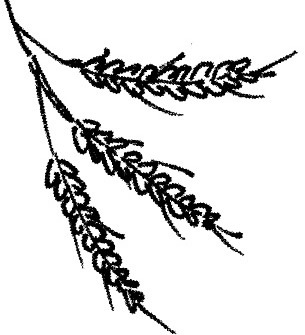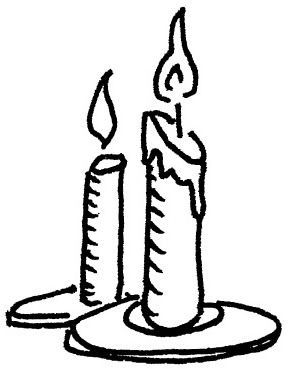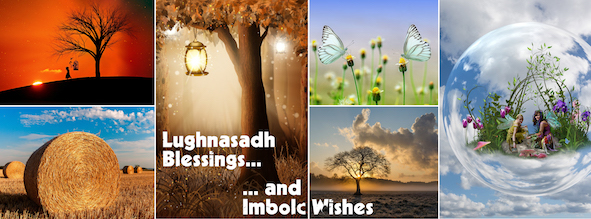The next sabbat in the Wheel of the Year – in the southern hemisphere anyway – is Lughnasadh. It marks the first day of autumn and the first harvest festival, and in 2018 it falls on February 4. It’s a day of celebrating the things we have metaphorically harvested, the things we’ve achieved, the gifts we’ve received, the experiences we’ve had, the talents we’ve developed and the things we’ve learned… (It’s also the first ritual Carlie takes part in in the Into the Mists series…)
I am so grateful for the many blessings in my life. For my beautiful husband, my loving family, my dear friends who mean so much to me. For the blessings of my health and the strength of my body, for the money I’d saved so that I’ve been able to focus on writing books since the magazines I edited closed down last year, for my writer friends who inspire me so much… For the opportunity to help others who need it through time, money and/or awareness…
 Lughnasadh, or Lammas, which is celebrated in the first week of February in the southern hemisphere and August in the north, is a cross-quarter day marking the end of summer and the beginning of autumn. It’s the first harvest festival, traditionally a time of feasting and of thanksgiving for the life-giving properties of the grain, as well as a recognition of the cycle of sowing and reaping of the crops – and of the symbolic things you grow and create in your life.
Lughnasadh, or Lammas, which is celebrated in the first week of February in the southern hemisphere and August in the north, is a cross-quarter day marking the end of summer and the beginning of autumn. It’s the first harvest festival, traditionally a time of feasting and of thanksgiving for the life-giving properties of the grain, as well as a recognition of the cycle of sowing and reaping of the crops – and of the symbolic things you grow and create in your life.
It’s a day of harvesting the fruits of your labours and acknowledging your successes and what you’ve achieved in the past year. Celebrate the goals you’ve reached and have your own festival of gratitude, in whatever form that takes. Toast your success, throw a party or do something special to mark the occasion. Make a list of all the things you’ve gained over the past year – the gifts you’ve been given, the new talents you’ve developed, the friends you’ve made, the experiences you’ve had, the healings you’ve received – and give thanks for it all. Then, out of gratitude and in the spirit of the ancestors who shared the bounty of their harvest with those less well off, pass on some of your good fortune. Make a donation to a local charity, lend money to a business in the developing world or give your time to help someone, ensuring the energy of abundance continues and is strengthened. Give out of grace and for joy, not with the expectation of receiving anything in return. Work out small ways you can make a difference to the world and the people around you all year.
As well as a time of feasting and thanksgiving for the harvesting of the crops, and recognition of the eternal cycle of sowing and reaping, Lughnasadh is also about the symbolic things you grow and create in your life. It’s a day to harvest what you planted earlier in the year and celebrate your successes. Make a list of all the things you’ve gained – the goals you reached, the gifts you’ve been given, the new talents you’ve developed, the friends you’ve made, the experiences you’ve had, the healings you’ve received, the opportunities you’ve pursued – and how you have developed and changed as a result of them.
Create a ritual of appreciation that is meaningful for you. You may want to journal about it, exploring in depth the things you’ve learned and the ways in which you’ve grown, send thank you cards to people who have helped you work towards your goals, start a gratitude diary or write a poem that outlines all that you’re grateful for. We may no longer be so connected to the production of our food, as in days gone by, or believe that our prayers or sacrifices influence the success of a crop, but appreciating what we have and giving thanks for it is still a beautiful way to live, and can increase our own attitude of abundance.
Also acknowledge all the things you’ve achieved so you can share your successes with others. Don’t be modest or downplay how far you’ve come, because you’ll inspire other people with stories of your breakthroughs, your dedication and details of how you overcame the obstacles you faced. Your successes will help them realise they can also pursue their dreams, and will hopefully give them the motivation they need to get started on their own journey.
Don’t ever diminish yourself or your achievements, or let anyone else do so. Be proud of your light, your talents and all your accomplishments, and always allow yourself to shine brightly and illuminate the darkness for others. As American author Marianne Williamson says: “Your playing small doesn’t serve the world. There’s nothing enlightened about shrinking so that other people won’t feel insecure around you. We are all meant to shine, and as we let our own light shine, we give other people permission to do the same.”
Now too, as the energy begins to subtly slow, it’s a time to be patient and to trust that everything is as it should be, because there are still harvests to come. Not everything has to be achieved right now – some things take longer to manifest. The lesson of the Wheel of the Year is that everything continues, everything happens when it should and everything is eternal.
 In the northern hemisphere at the same time people will be celebrating Imbolc, the festival that marks the beginning of spring, and celebrates the fact that the days are lengthening and the light is returning, illuminating the land and our own hearts.
In the northern hemisphere at the same time people will be celebrating Imbolc, the festival that marks the beginning of spring, and celebrates the fact that the days are lengthening and the light is returning, illuminating the land and our own hearts.
Mythologically, this was when the goddess transformed into the maiden and waiting bride, signified by the new blossoms and the quickening energy within the earth, and the infant god continued to grow in power, represented by the longer days and increasing strength of the sun. Astronomically, the cross-quarter day of Imbolc falls midway between the winter solstice and the spring equinox. In the southern hemisphere the sun is in the middle of its journey back from the lowest latitudes to the equator, and rises in the same position as it did at Samhain, when it was heading south from the equator towards its Midwinter point.
Energetically it’s a time of awakening, renewal and re-emergence, as nature fills with life force and begins to quiver with the energy to grow again, and we too start to emerge from the chill of winter, shaking off our inertia and lack of motivation and beginning to re-engage with the world. It’s also a time of purification and cleansing after the long dark of the winter months, of stripping away the old so the new can emerge. Imbolc is one of the four fire festivals of the year, and great bonfires would be lit not only in celebration but also for purification, so cleansing has always been an important aspect of the day.
Imbolc remains a day to honour the fertility of the land and our own selves. As the first signs of spring start to manifest, and the earth quickens with an energy that can be tangibly felt, it’s a powerful time to do healing work of any kind, and send energy to friends around the world. You can also increase your knowledge in an area you’re interested in, expand your creativity and tend to activities that are overlooked in the busy months of summer – making candles, sewing dream pillows, grinding herbs and blessing the seeds you’ll plant in spring…
* From Seven Sacred Sites: Magical Journeys That Will Change Your Life.



Get Social